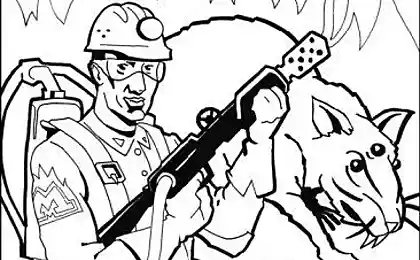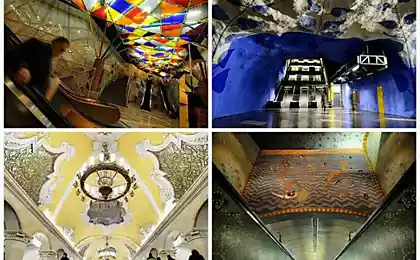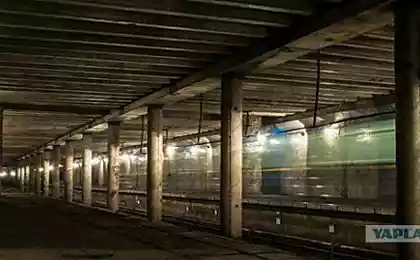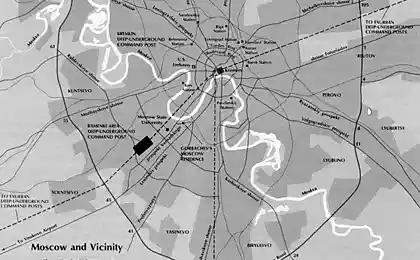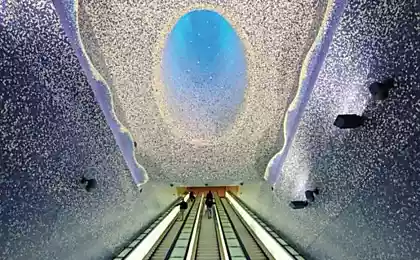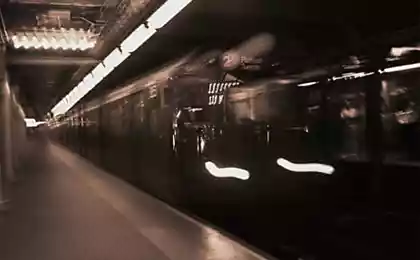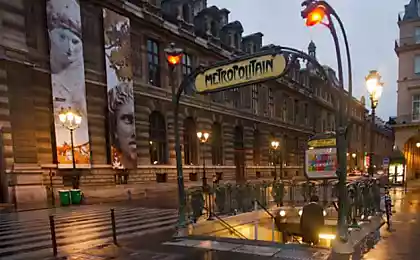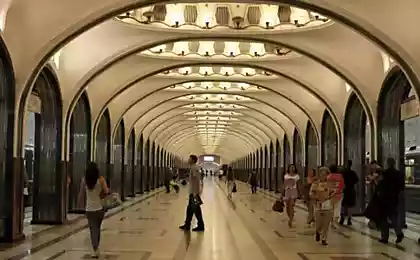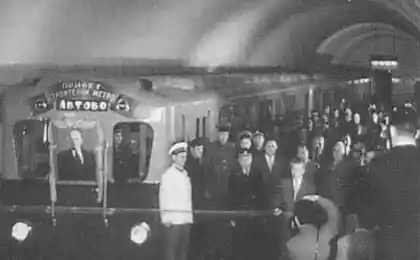1254
High subway station
Today I tell you about the station «Smith-9 Streets» - the highest underground station in the world. As in the case of "rotation suicide" it was not whim builders and forced engineering solution. Moreover, it was the only area in the entire system of IND, which comes to the surface. And that was a good reason.

The reason is the channel with the sonorous name Gowanus, which was once an important transport artery connecting large industrial area with the waters of New York Bay. Now shipping almost died, but in those days it was literally overflowing with tugs, barges and cargo ships. All urban industrial area were equipped on the shores of the Gulf, and cargo transportation was primarily on the water. The ships were so many, that in the period between the world wars, Gowanus Canal was the busiest in the country. Then developed network of roads, trucks, and economic crisis of the 70 killed water transport in New York City and the canal is almost dead. The legacy of the old days he got a large number of industrial buildings on the banks, but enormous pollution of its waters, making it the most environmentally disadvantaged Gowanus place in the city today. The waters of the channel is considered one of the most polluted, not only in New York but also in the United States. According to the banks does not remain running productions, but some land contaminated so that many more years here will not conduct any construction.

Well, back to our subway. His New York so no one calls, but I'll be out of habit sometimes. When in 1932, the company owned by the city IND decided to build a new branch in Brooklyn, then faced the challenge of crossing the channel. They had only two options: to build a, or build over water. Rock, leaving little to the surface in the area, inflated estimates of the construction of the tunnel to almost prohibitive quantities. Plus, the laying of the tunnel was a matter of not fast, that will shift the deadlines for all the branches. Therefore it was decided to go over the canal. But then the company's management had to make another choice: to pave the way for the drawbridge (as done in the north of Manhattan IRT), which is relatively cheap, but in the future will greatly affect the train schedule, or to build on nerazvodnomu that will be significantly more expensive iz the fact that it is necessary to raise the railroad tracks at high altitude, but will give full independence from walking on the water ships. The requirement for high altitude Viaduct was understandable. It is now a sailing ship rare, exotic and fun for people with money, and then the sailboats were full participants in the process of cargo and dimensions necessarily taken into account in the construction of bridges (which is why in New York, all the bridges are so high). That is a viaduct under construction had to be so high that it could pass for a sailing ship with a mast.

Driving hanging in the lobby of the station. There is clearly visible channel line metro station and location.
But what about the rest of the two companies? - Perhaps you ask. (you know, that the New York subway built three different companies?) It's very simple. Gowanus Canal is actually a deeper bed of the stream and he did with nothing is not connecting. In fact, it is a water hose stretching 1.8 miles into Brooklyn. The company began building its IND branches later than the other (it was founded only in 1932), when the BMT and IRT has paved its branches in Brooklyn. They are built above and east of the channel and they do not have to think about how to bypass it, but the company IND was already nowhere to go. By 1938, she had a variety of small, either not to build a branch at all, and to lose a tasty piece of Brooklyn, as well as the prospect to extend the subway through the tunnel on the Staten Island (was also a draft), or to build this way. We had to build as it is, ie, lift line in the sky.

Of the birds in the sky and I'm not very something and bent. The height of the rack on which the station - 26.7 meters. It's almost like a normal subway running underground (in Moscow, the depth of most stations, and even less), but not under and over it.
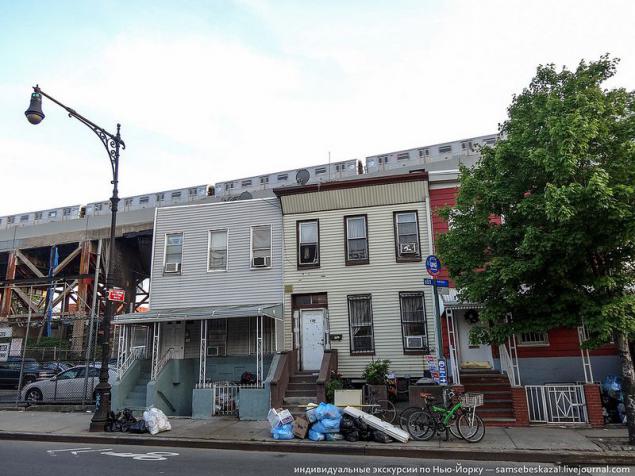
The construction of the viaduct is unique even for New York, with its historical love of overhead branches. In one place the rack passes directly over the building, which was erected in 1929, that is, even before its construction.

The station is located above the drawbridge. I do not check this fact, but it seems to me that it is the only station in the world located in such an unusual place.
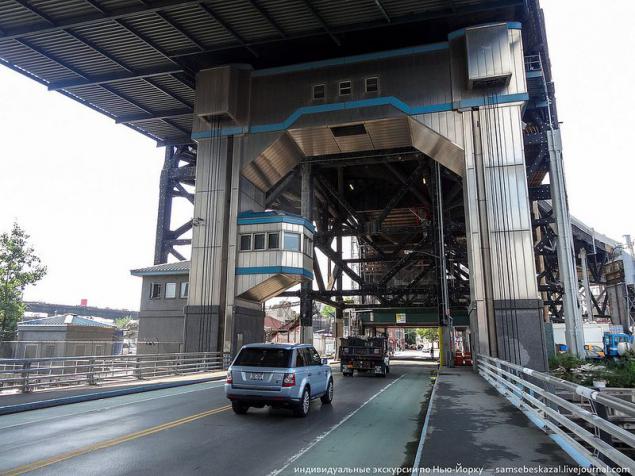
Viaduct called "Culver Viaduct". Andrew Culver was the founder and president of the railroad «Prospect Park and Coney Island» branch which was stretched from Prospect Park to the hotel Cable on Coney Island. The company was later sold, the way raised above the ground and now it goes on the train line from the station F. Branch Jay Street - MetroTech to a final Coney Island - Stillwell Avenue called the Culver line.
Once a station with the most beautiful views of Manhattan and the surrounding area. So here you can easily find a photographer who wants to make the skyscrapers of Manhattan at sunset from an unusual angle.
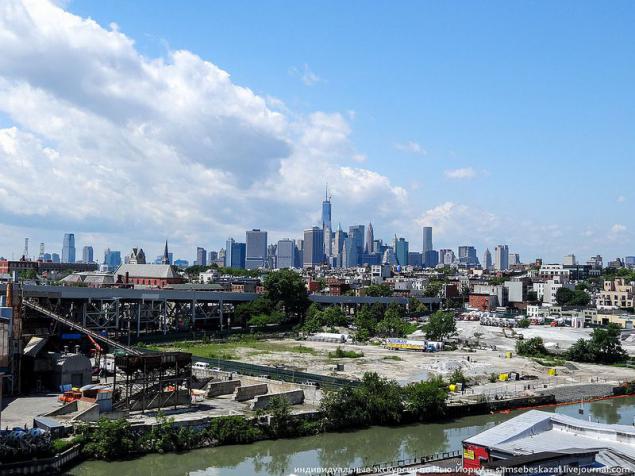
The photo descend toward the station Carroll Street. Just a little bit, and the train goes underground.
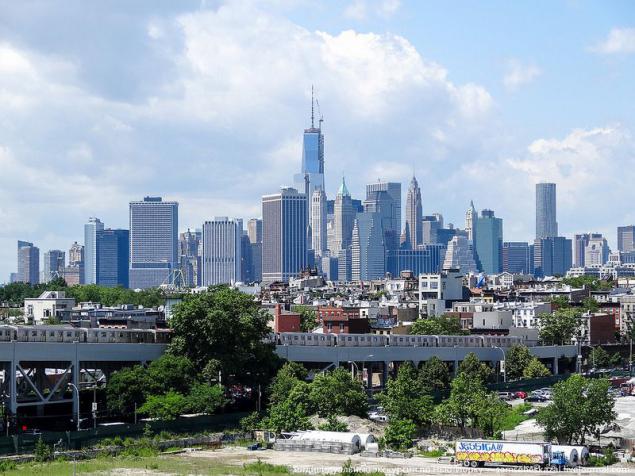
On the viaduct is two metro stations: Smith-9 Streets and Fourth Avenue, and runs two lines: F and G.

Two years station overhaul, and the train passed it without stopping. Several months ago, the station opened for the passengers, but the reconstruction is still underway.

We can see an interesting structure of the supports, which are made of iron and coated with a layer of concrete. During repair, all concrete is completely tore off, and the iron was treated with modern anti-corrosion coatings. Part of the overpass which has not yet had time to update covered with black tape. It protects the structure from excessive moisture and heads of passers-by flying pieces of concrete down to fall off with age and constant vibration.

Lobby.
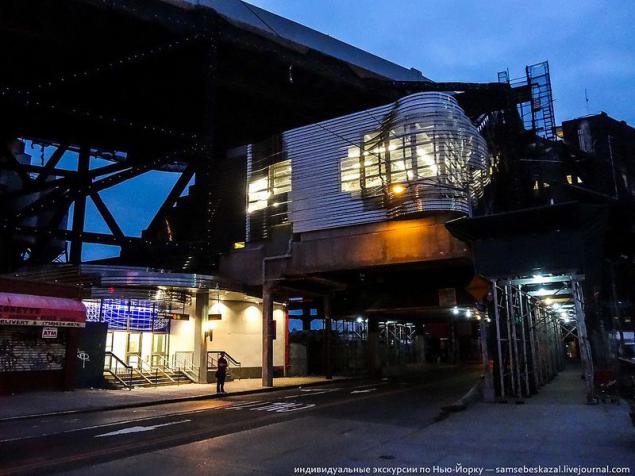
Go inside.
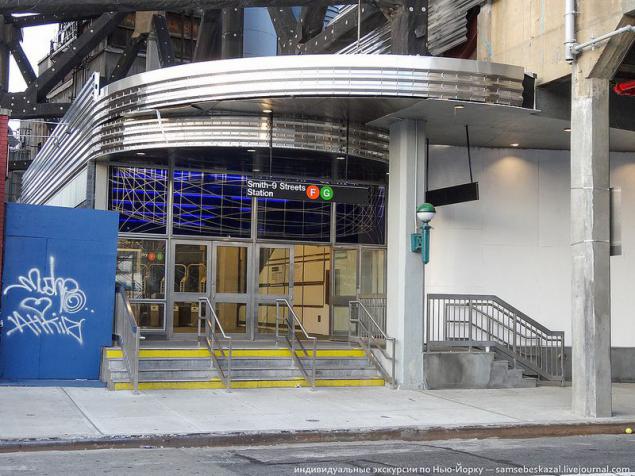
On the platform is three escalators. The two worked on the rise, and one on the descent.
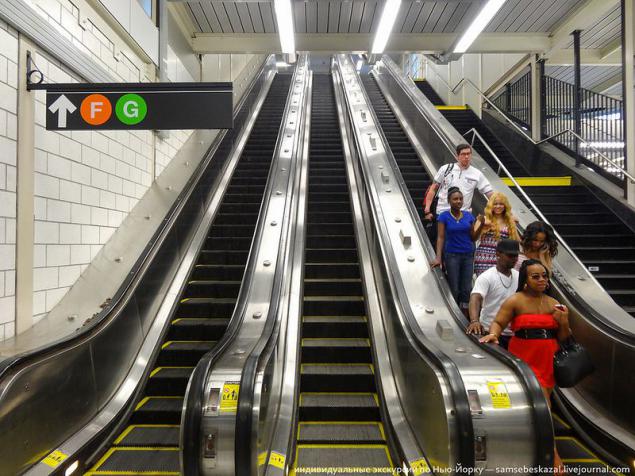
Rising to the site it is necessary to make a connection to the next escalator.
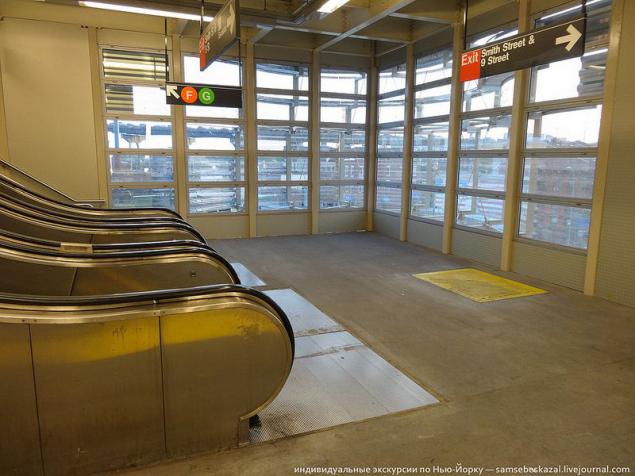
It seems that the goal is near, but it is not.
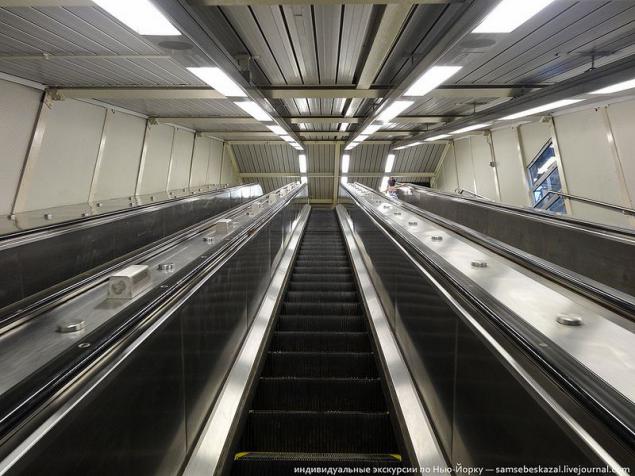
At the end of the second escalator you will find another space. You've got to choose the direction: left Manhattan, Coney Island right.

When you have finally decided that the recovery is completed, you will find a surprise in the form of a fairly steep staircase. Here I do not envy the elderly and passengers with a stroller, they have no alternative.

Overcoming the rise you finally find yourself on the platform.

View from the platform side of Manhattan.
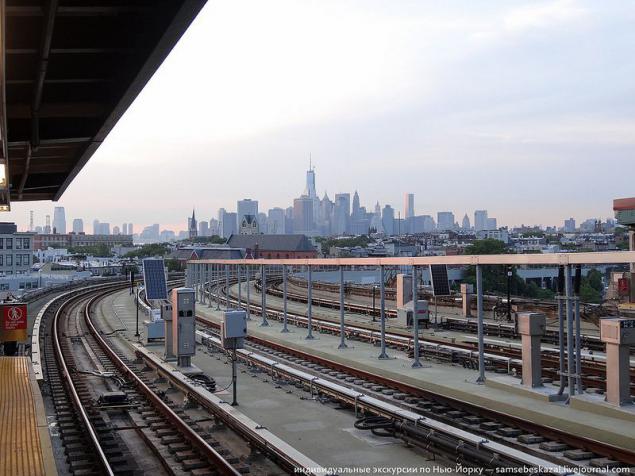
The view from the driver's cab.

The design of the station.
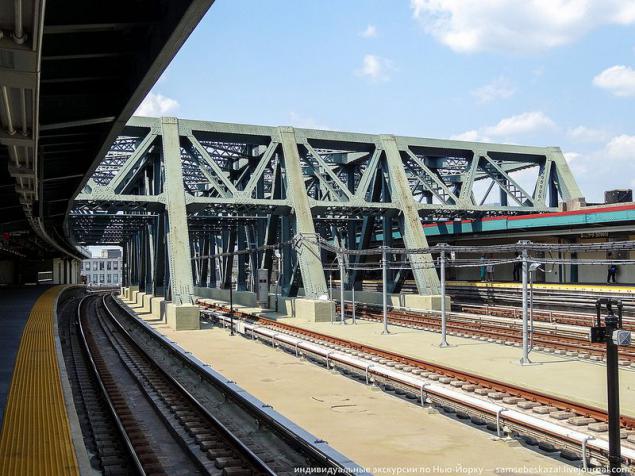
This view of the opposite side.
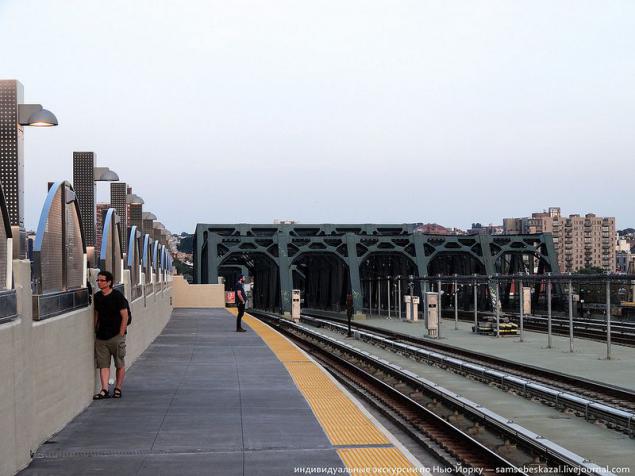
Finishing station is not rich, but quite original. Windows on the grounds, for example, covered with old maps of New York.

The windows are closed at the top grille with fine mesh. Shoot through them very uncomfortable.
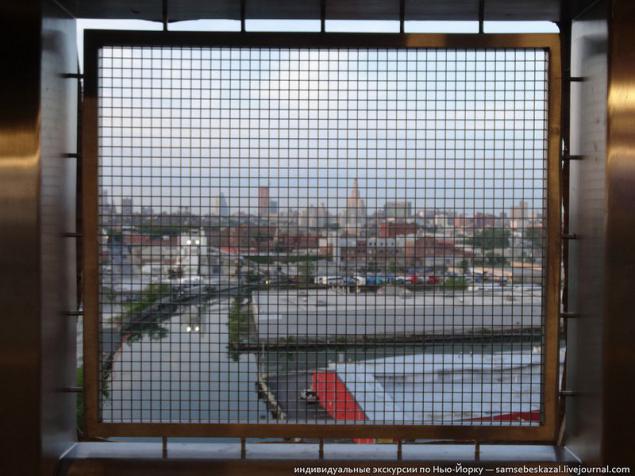
The lamp and the station name.
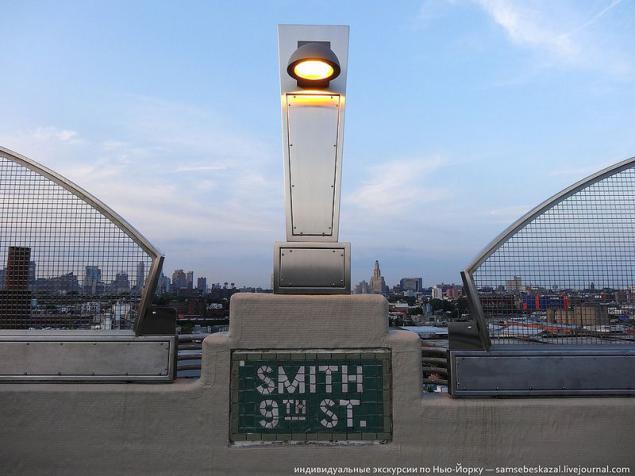
On closer inspection it turned out to be a mosaic of lime. It's just printing on vinyl film. Mosaic restore later
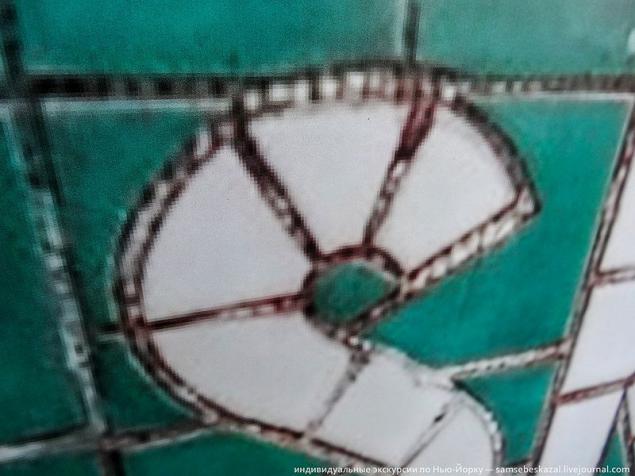
Forms platform. On the one hand it can be seen downtown Brooklyn and skyscraper Willie.

Abandoned building an electrical substation, which previously served the metro line. Place called the Bat Cave.
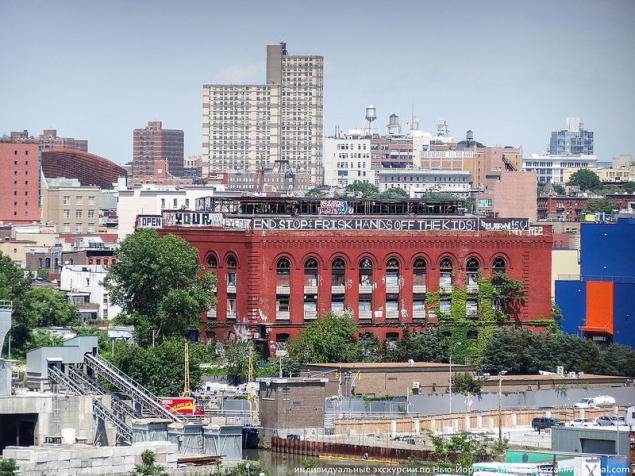
Parking double-decker tourist buses.
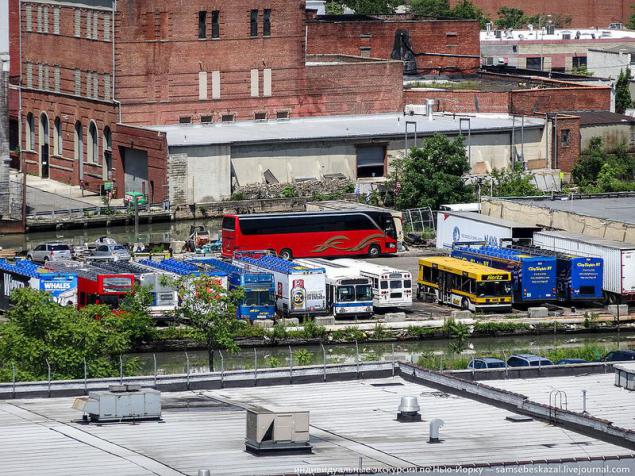
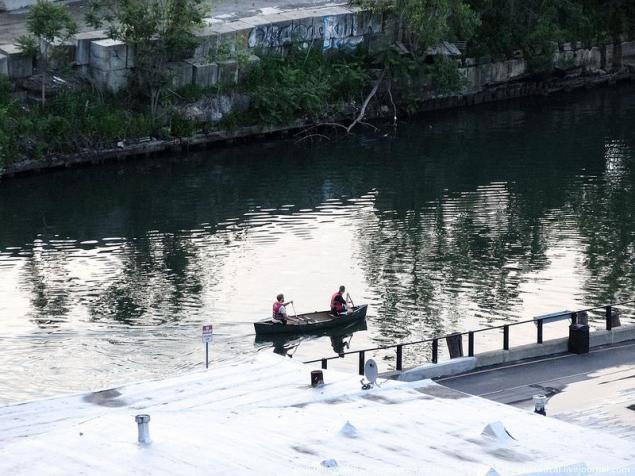
On the other hand there is a large supermarket products for the construction and home Lowe's.
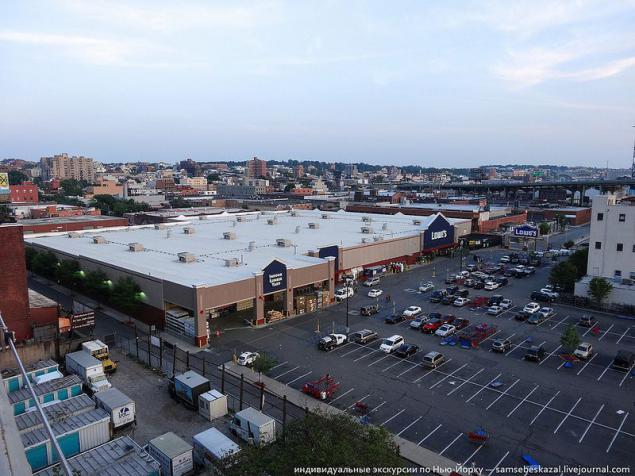
A parallel road is Gowanus-ekspressvey in the neighborhood where I once walked. Her builders and designers had the same problem with the height of the canal. Right base metal reception from the public. He then loaded onto a barge and taken for processing.

On the horizon are seen cranes container terminal Nyuark Elizabeth in New Jersey.
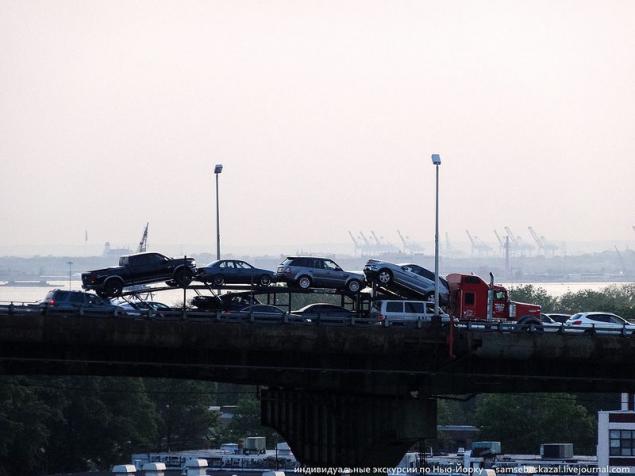
The view from the window of the car resembles the view from the airplane, when he comes in to land.
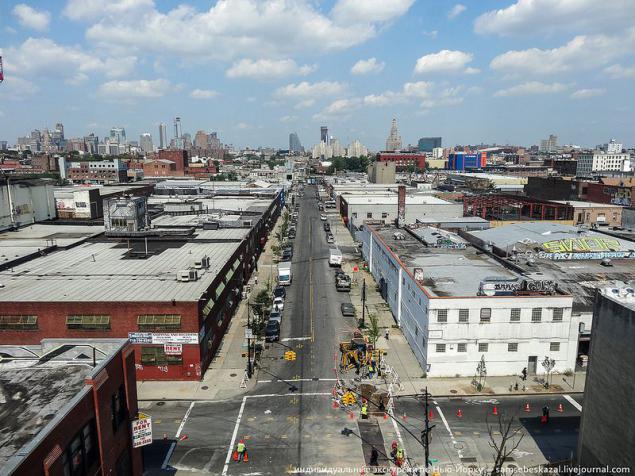
View of the station from the parking lot of the supermarket. All covered with black film still being repaired.
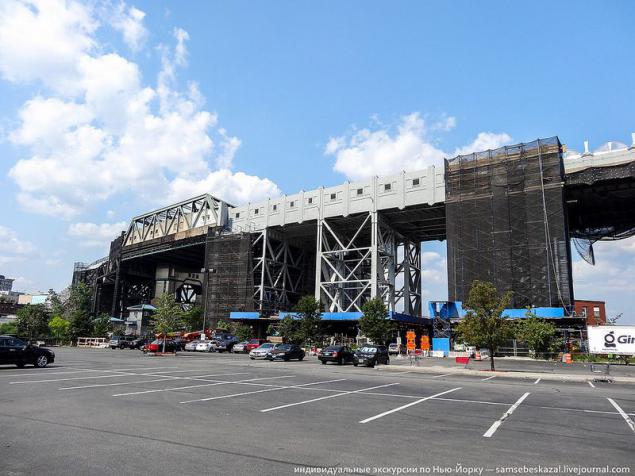
Small park directly on the Gowanus.

Views from the shops exciting.
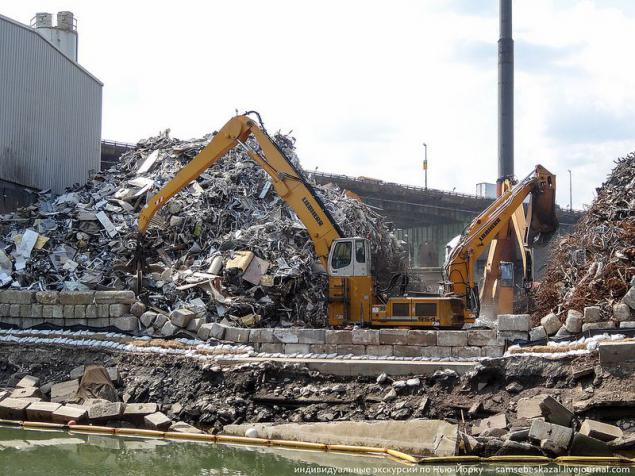
The smell from the water also brings a lot of fun.

Severe birdhouse.
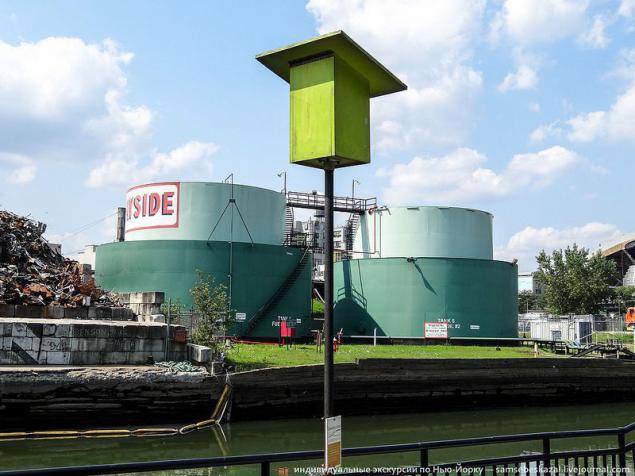
Source: samsebeskazal.livejournal.com

The reason is the channel with the sonorous name Gowanus, which was once an important transport artery connecting large industrial area with the waters of New York Bay. Now shipping almost died, but in those days it was literally overflowing with tugs, barges and cargo ships. All urban industrial area were equipped on the shores of the Gulf, and cargo transportation was primarily on the water. The ships were so many, that in the period between the world wars, Gowanus Canal was the busiest in the country. Then developed network of roads, trucks, and economic crisis of the 70 killed water transport in New York City and the canal is almost dead. The legacy of the old days he got a large number of industrial buildings on the banks, but enormous pollution of its waters, making it the most environmentally disadvantaged Gowanus place in the city today. The waters of the channel is considered one of the most polluted, not only in New York but also in the United States. According to the banks does not remain running productions, but some land contaminated so that many more years here will not conduct any construction.

Well, back to our subway. His New York so no one calls, but I'll be out of habit sometimes. When in 1932, the company owned by the city IND decided to build a new branch in Brooklyn, then faced the challenge of crossing the channel. They had only two options: to build a, or build over water. Rock, leaving little to the surface in the area, inflated estimates of the construction of the tunnel to almost prohibitive quantities. Plus, the laying of the tunnel was a matter of not fast, that will shift the deadlines for all the branches. Therefore it was decided to go over the canal. But then the company's management had to make another choice: to pave the way for the drawbridge (as done in the north of Manhattan IRT), which is relatively cheap, but in the future will greatly affect the train schedule, or to build on nerazvodnomu that will be significantly more expensive iz the fact that it is necessary to raise the railroad tracks at high altitude, but will give full independence from walking on the water ships. The requirement for high altitude Viaduct was understandable. It is now a sailing ship rare, exotic and fun for people with money, and then the sailboats were full participants in the process of cargo and dimensions necessarily taken into account in the construction of bridges (which is why in New York, all the bridges are so high). That is a viaduct under construction had to be so high that it could pass for a sailing ship with a mast.

Driving hanging in the lobby of the station. There is clearly visible channel line metro station and location.
But what about the rest of the two companies? - Perhaps you ask. (you know, that the New York subway built three different companies?) It's very simple. Gowanus Canal is actually a deeper bed of the stream and he did with nothing is not connecting. In fact, it is a water hose stretching 1.8 miles into Brooklyn. The company began building its IND branches later than the other (it was founded only in 1932), when the BMT and IRT has paved its branches in Brooklyn. They are built above and east of the channel and they do not have to think about how to bypass it, but the company IND was already nowhere to go. By 1938, she had a variety of small, either not to build a branch at all, and to lose a tasty piece of Brooklyn, as well as the prospect to extend the subway through the tunnel on the Staten Island (was also a draft), or to build this way. We had to build as it is, ie, lift line in the sky.

Of the birds in the sky and I'm not very something and bent. The height of the rack on which the station - 26.7 meters. It's almost like a normal subway running underground (in Moscow, the depth of most stations, and even less), but not under and over it.

The construction of the viaduct is unique even for New York, with its historical love of overhead branches. In one place the rack passes directly over the building, which was erected in 1929, that is, even before its construction.

The station is located above the drawbridge. I do not check this fact, but it seems to me that it is the only station in the world located in such an unusual place.

Viaduct called "Culver Viaduct". Andrew Culver was the founder and president of the railroad «Prospect Park and Coney Island» branch which was stretched from Prospect Park to the hotel Cable on Coney Island. The company was later sold, the way raised above the ground and now it goes on the train line from the station F. Branch Jay Street - MetroTech to a final Coney Island - Stillwell Avenue called the Culver line.
Once a station with the most beautiful views of Manhattan and the surrounding area. So here you can easily find a photographer who wants to make the skyscrapers of Manhattan at sunset from an unusual angle.

The photo descend toward the station Carroll Street. Just a little bit, and the train goes underground.

On the viaduct is two metro stations: Smith-9 Streets and Fourth Avenue, and runs two lines: F and G.

Two years station overhaul, and the train passed it without stopping. Several months ago, the station opened for the passengers, but the reconstruction is still underway.

We can see an interesting structure of the supports, which are made of iron and coated with a layer of concrete. During repair, all concrete is completely tore off, and the iron was treated with modern anti-corrosion coatings. Part of the overpass which has not yet had time to update covered with black tape. It protects the structure from excessive moisture and heads of passers-by flying pieces of concrete down to fall off with age and constant vibration.

Lobby.

Go inside.

On the platform is three escalators. The two worked on the rise, and one on the descent.

Rising to the site it is necessary to make a connection to the next escalator.

It seems that the goal is near, but it is not.

At the end of the second escalator you will find another space. You've got to choose the direction: left Manhattan, Coney Island right.

When you have finally decided that the recovery is completed, you will find a surprise in the form of a fairly steep staircase. Here I do not envy the elderly and passengers with a stroller, they have no alternative.

Overcoming the rise you finally find yourself on the platform.

View from the platform side of Manhattan.

The view from the driver's cab.

The design of the station.

This view of the opposite side.

Finishing station is not rich, but quite original. Windows on the grounds, for example, covered with old maps of New York.

The windows are closed at the top grille with fine mesh. Shoot through them very uncomfortable.

The lamp and the station name.

On closer inspection it turned out to be a mosaic of lime. It's just printing on vinyl film. Mosaic restore later

Forms platform. On the one hand it can be seen downtown Brooklyn and skyscraper Willie.

Abandoned building an electrical substation, which previously served the metro line. Place called the Bat Cave.

Parking double-decker tourist buses.


On the other hand there is a large supermarket products for the construction and home Lowe's.

A parallel road is Gowanus-ekspressvey in the neighborhood where I once walked. Her builders and designers had the same problem with the height of the canal. Right base metal reception from the public. He then loaded onto a barge and taken for processing.

On the horizon are seen cranes container terminal Nyuark Elizabeth in New Jersey.

The view from the window of the car resembles the view from the airplane, when he comes in to land.

View of the station from the parking lot of the supermarket. All covered with black film still being repaired.

Small park directly on the Gowanus.

Views from the shops exciting.

The smell from the water also brings a lot of fun.

Severe birdhouse.

Source: samsebeskazal.livejournal.com
